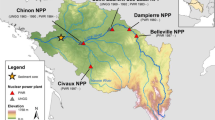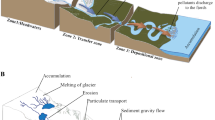Abstract
The transuranium elements, Np, Pu and Am discharged from the BNFL fuel reprocessing plant at Sellafield have accumulated in the local environment. The processes responsible for their dispersal rely both on physical transportation and their chemical reactivity. The transuranics have a complex chemistry, with multiple oxidation states and a strongly polarising character. In the environment, the particle active III/IV and more mobile VNI oxidation state groups are important and govern their geochemical behaviour and subsequent dispersal.
Studies of the behaviour of the transuranics, particularly Pu, in the Irish Sea, have shown that the majority of the radionuclides in the liquid effluent discharged from Sellafield, quickly becomes associated with the marine sediments. Their dispersal and distribution in the environment is then governed primarily by the movement of particulate material and for some sites it has been suggested that sediment profiles preserve the historical record of discharges from the plant.
In tidally inundated soils, radionuclide levels are greatly enhanced. These soils are water-logged for long periods of the year, are strongly anoxic and accretion rate are very low. The distribution of Np, Pu and Am in the soil suggests that simple sedimentary accumulation mechanism cannot provide an adequate explanation for the profiles observed. From preliminary studies of soil pore water composition and detailed analysis of the variation of isotopic ratios in the soil cores, it is apparent that a small but significant component of the radionuclide inventory is mobile. In addition, it is clear that the mechanisms responsible for this mobility allows differentiation between the transuranium nuclides.
Similar content being viewed by others
References
Allard, B., Olofsson, U. and Torstenfelt, B. 1984. Environmental actinide chemistry.Inorg. Chim. Acta,94, 205–221.
Assinder, D.J., Kelly, M. and Aston, S.R. 1985. Tidal variation in dissolved and particulate phase radionuclide activities in the Esk estuary, England and their distribution coefficients and their particulate activity fractions.J. Environ. Radioact.,2, 1–22.
Aston, S.R. and Stanners, D.A. 1981a. Observations on the deposition, mobility and chemical associations of plutonium in intertidal sediments. In:Techniques for Identifying Transuranic Speciation in Aquatic Environments, pp. 195–208. IAEA-STI/PUB/613, Vienna.
Aston, S.R. and Stanners, D.A. 1981. Plutonium transport to and deposition and immobility in Irish Sea intertidal sediments.Nature,289, 581–582.
Baas-Becking, L.G.M., Kaplan, I.R. and Moore, D. 1960. Limits of the natural environment in terms of pH and oxidation-reduction potentials.J. Geol.,68, 243–284.
Bittel, R. 1984. Mobile forms of Pu and Np and heterogeneous equilibrium parameters in estuaries, consequences to public health.Proceedings of the International Seminar on the Behaviour of Radionuclides in Estuaries, Renesse, 15–17 September, pp.305–312.
Burton, P.J. 1986. Laboratory studies on the remobilisation of actinides from Ravenglass estuary sediment.Sci. Total Environ.,52, 123–145
Chester, R. 1990.Marine Geochemistry. Unwin Hyman, London.
Choppin, G.R. 1988. Humics and radionuclide migration.Radiochim. Acta,44/45, 23–28.
Cleveland, J.M. and Rees, T.F. 1976. Investigation Of the solublisation of Pu and Am by natural humic compounds.Environ. Sci. Technol.,10, 802–806.
Cleveland, J.M. and Rees, T.F. 1981. Characterisation of plutonium in Maxey Flats radioactive trench leachate.Science,212, 1506–1509.
Hamilton-Taylor, J., Kelly, M., Mudge, S. and Bradshaw, K. 1987. Rapid remobilisation of Pu from estuarine sediments.J. Environ. Radioact.,5, 409–424
Hursthouse, A.S. 1990. Development and application of methods for the assay of neptunium in environmental matrices. PhD Thesis, University of Glasgow.
Hursthouse, A.S., Baxter, M.S., Livens, F.R. and Duncan, H.J. 1991. Transfer of Sellafield-derived neptunium to and within the terrestrial environment.J. Environ. Radioact.,14, 147–174.
IAEA. 1986. Sediment Kd’s and concentration factors for radionuclides in the marine environment. Technical Report, No.247. IAEA, Vienna.
Ivanovich, M. and Harmon, R.S. 1982.Uranium Series Disequilibrium. Clarendon Press, Oxford.
Jensen, B S. 1980. The geochemistry of radionuclides with long half-lives: their expected migration behaviour. RISØ-R-430, Risø National Laboratory, Denmark.
Kelly, M., Mudge, S., Hamilton-Taylor, J. and Bradshaw, K. 1988. Behaviour of dissolved plutonium in the Esk estuary, UK. In: Guary, J.C., Gueguenait, P.M. and Pentreath R.J. (eds),Radionuclides: a Tool for Oceanography, pp.321–330. Elsevier Applied Science, Oxford.
Kershaw, P.J., Swift, D.J., Pentreath, R.J. and Lovett, M.B. 1983. Plutonium redistribution by biological activity in Irish Sea sediments.Nature,306, 774–775.
Kershaw, P.J., Woodhead, D.S., Malcolm, S.J., Allington, D.J. and Lovett, M.B. 1990. A sediment history of Sellafield discharges.J. Environ. Radioact.,12, 201–242.
Kirchner, G. 1990. A new hazard index for the determination of risk potentials of disposed radioactive wastes.J. Environ. Radioact.,11, 71–97.
Livens, F.R. 1985. Geochemistry of plutonium and other artificial radionuclides in Cumbrian soils. PhD. Thesis, University of Glasgow.
Livens, F.R. 1991. Chemical reactions of metals with humic materials.Environ. Pollut.,70, 183–208.
Livens, F.R. and Baxter, M.S. 1988. Chemical associations of artificial radionuclides in Cumbrian soils.J. Environ. Radioact.,7, 75–86.
Livens, F.R., Baxter, M.S. and Allen, S.E. 1987. Association of plutonium with soil organic matter.Soil Sci.,144, 24–28.
Livens, F.R., Baxter M.S. and Allen S.E. 1986. Physicochemical associations of plutonium in Cumbrian soils. In: Bulman, R.A. and Cooper, J.R. (eds),Speciation of Fission and Activation Products in the Environment, pp.143–150. Elsevier Applied Science, Oxford.
Livens, F.R. and Singleton, D.L. 1991. Plutonium and americium in soil organic matter.J. Environ. Radioact.,13, 323–340.
Livens, F.R., Horrill, A.D. and Singleton, D.L. 1992. Sampling and measurement of transuranic elements in interstitial waters of sediments,Appl. Radiat. Isot.,43(1/2), 361–369.
MacKenzie, A.B., Scott, R.D. and Williams, T.M. 1987. Mechanisms for the northward dispersal of Sellafield waste.Nature,329, 42–45.
Maes, A. and Cremers, A. 1986. Radionuclide sorption in soils and sediments: oxide-organic matter competition. In: Bulman, R.A. and Cooper, J.R. (eds),Speciation. of Fission and Activation Products in the Environment, pp.793–799. Elsevier Applied Science, Oxford.
Mudge, S., Hamilton-Taylor, J., Kelly, M. and Bradshaw, K. 1988. Laboratory studies of the chemical behaviour of Pu associated with contaminated estuarine sediments.J. Environ. Radioact.,8, 217–237
Mudge, S., Kelly, M., Hamilton-Taylor, J. and Bradshaw, K. 1989. Behaviour of plutonium in estuarine environments. Contract Report to Department of the Environment DOE/HMIP/RR/91/001.
Munsell Color Co. Inc. 1954.Munsell Soil-Colour Charts. Baltimore, USA.
Nelson, D.M. and Lovett, M.B. 1981. Measurements of the oxidation state and the concentration of plutonium in interstitial waters of the Irish Sea. In:Impacts of Radionuclide Release to the Marine Environment, pp.105–118. STI/PUB/565. IAEA, Vienna.
Sholkovitz, E.R. 1983. The geochemistry of plutonium in fresh and marine water environments.Earth-Science Rev.,19, 95–161.
Author information
Authors and Affiliations
Rights and permissions
About this article
Cite this article
Hursthouse, A.S., Livens, F.R. Evidence for the remobilisation of transuranic elements in the terrestrial environment. Environ Geochem Health 15, 163–171 (1993). https://doi.org/10.1007/BF02627834
Received:
Accepted:
Issue Date:
DOI: https://doi.org/10.1007/BF02627834




